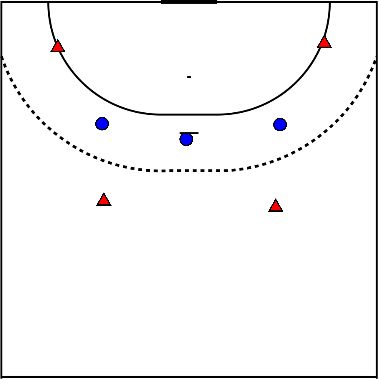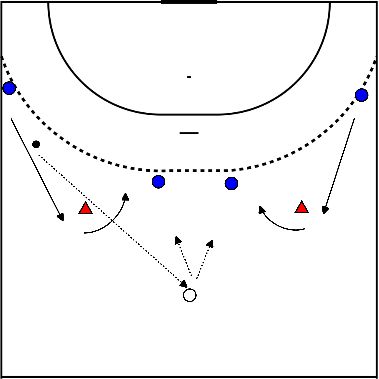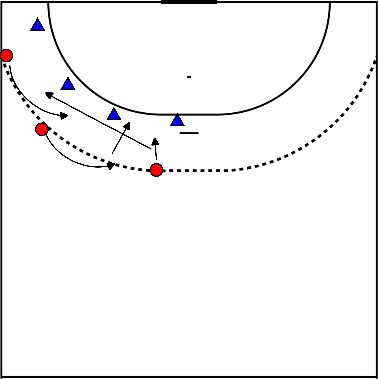Handball drills for technique attack / offense
- 2 players facing each other, with tennis ball.
- Hold upper arm and overplay ball with forearm/wrist.
- Pass over with hip throw.
- Trainer stands center front at 7 meters.
- Player throws on ball from 11/ 12 meters, runs up, catches ball and shoots under arms trainer, with side shot.
- Note low body position.
Practice passing moves in small 2-meter space.
1. Right - right wide - left)
2. Left, left wide - right - left - with overhaul.
3. 3 pass with extended forward throwing arm.
4. Turn -right turn to pass left - left turn to pass right.
1. Right - right wide - left)
2. Left, left wide - right - left - with overhaul.
3. 3 pass with extended forward throwing arm.
4. Turn -right turn to pass left - left turn to pass right.
- 3 defenders with vests - 4 attackers.
- 4 markers on the ground - see drawing - approximate position attackers.
- The attackers try, through good interplay with the corner players, to get the ball on the ground in the 6 meters. Not throwing but laying down - 1 point.
- The defenders try to touch an attacker who has the ball - 1 point.
- Above all play each other freely, no passing moves and the like.

- At 3 spots(LO/MO/RO) place a dummy or poles with vests.
- Players approach from 1 side, get the ball and after 2 steps from the 2nd line they finish 3 times with:
- High stretch/ swing shot.
- Underhand shot.
- Articulated shot.
- Have left-handed players start on the right.
- Focus on ball control.
- Lots of repetitions.
Circuit:
- Zig-zag partoon with flat markers: walk forward and backward, pay attention to light stride, especially forefoot.
- Then dribble to:
- Goal on side next to center line, put bench in front of it. Make jump shot.
- Left of goal 5 pawns: dribble slalom
- Do a head roll on the mat.
- Then to the right, there is a pawn at 6 meters, very diagonal to the goal. Make jump shot at 2 pawns standing in the goal.
At 3 positions, within the 9 meters, lay down marking circles.
- 2 for the null pass, then right-left-right or left-right-left.
- No jumping.
- Finishing on 1 leg standing and falling forward is allowed.
- Two rows facing each other along the sideline.
- On both sides, two players start 1 with ball, 1 without ball
- At 3 meters distance the ball is played to the trainer (center line)
- Players walk around the pawn.
- Get the ball, play over and finish on goal.

We play this to practice the previous exercises at high speed and in competition form.
- 3-vs-3 without circle. Point of attention in attack: lots of movement, don't hang on your spot. Point of attention in coverage: who steps out when.
- 3-vs-4 with circle. Cover is undermanned and tries to break the attack by taking the speed out of it.
- 4-vs-4. The coverage is now complete with a circle in their back. Again, focus on who has the circle at what time and when they should step out.
- 5-vs-5. Same as before only now first LH and then RH are involved.
All players start on the LO in a line, everyone has a ball. In the field there are poles to finish on the spots LH, LO, MO, RO, RH.
- Player 1 starts with a cross and shoots at goal.
- Player 1 walks backwards to the LO, picks up the ball there.
- Player 1 rounds the LO, passes to MO etc.
This has to be done on a high tempo and with high intensity! Players must be tired.
- 2 Benches face each other, between 6 and 8 meters apart
- On every bench there are 4 to 6 pawns
- There are 2 teams who must try to knock off the pawns by throwing them over.
- Pawns that have fallen down can be taken to your own side
- The team that has all the pawns wins
Outdoors:
- Place the pawns in bicycle tires, where you are not allowed to stand inside.
- 2 Teams
- Players place themselves on call on both sides at the 5 defensive positions: LH-LO-MO-RO-RH
- Then run to attack position
- Then a minimum of 3 throws (e.g. MO-RO-RH-RO)
- Then shot at pawn
- Return to defense
- Players out, players in
- Back to offense
- Again at least 3 throws
- Shot on target, etc.
- Who is the first to knock over 3 pawns wins
- Ball goes from the set-up to the middle set-up
- Middle build-up breaks away and starts in towards the middle and passes the ball to the incoming corner
- Corner puts pressure between 2 and 3
- The build-up passes behind the corner at the level of 2 and 3 and finishes in the middle.








